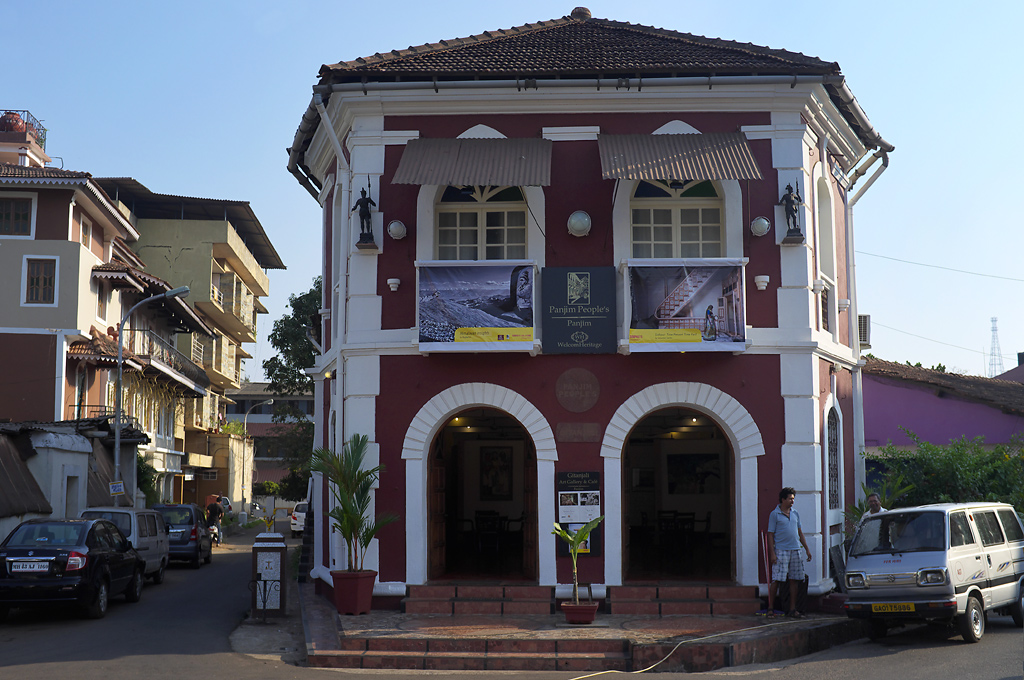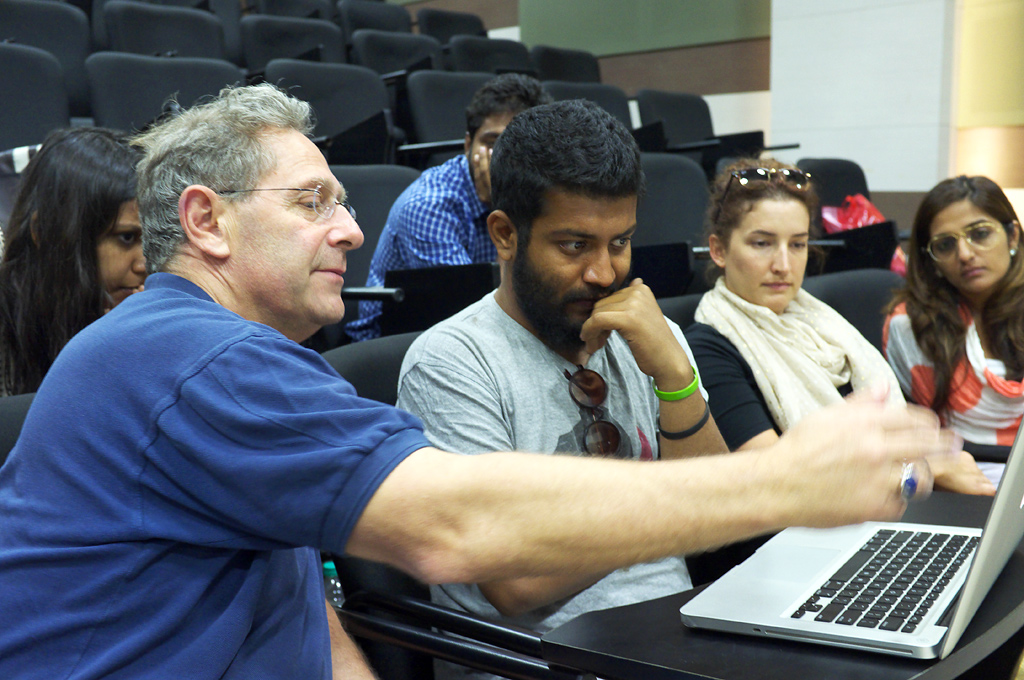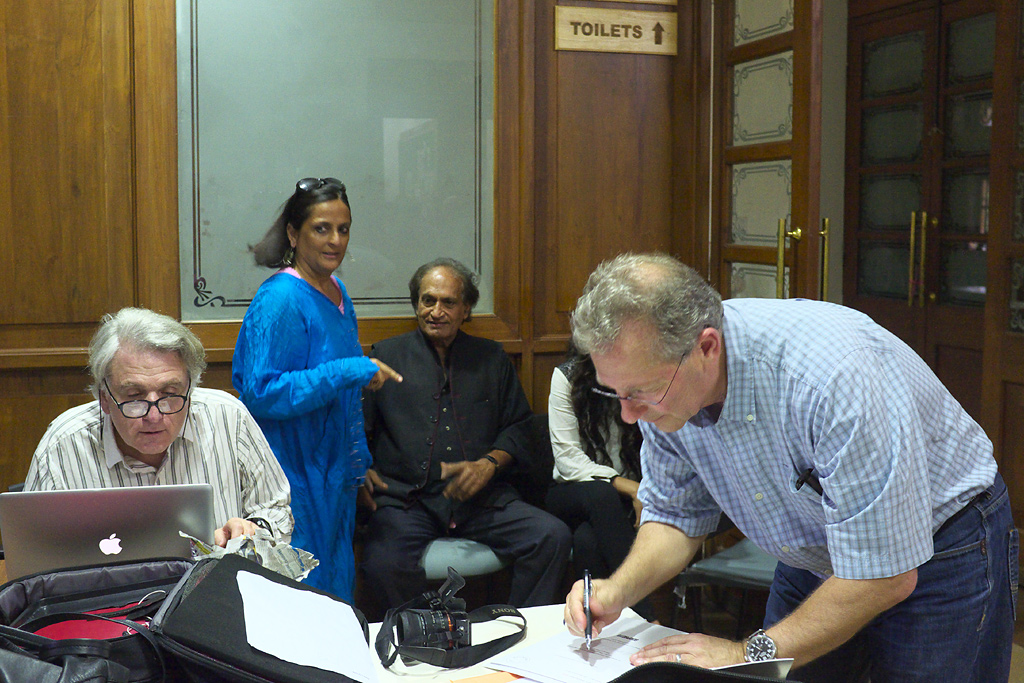_____________________________________________________________________________________________________________________________
[Home]
Magnum Photo - Workshop in Goa
An experience report
 Our Lady Of The Immaculate Conception Church, Panjim – GoaPhoto 2015 |
||
| From
February 25 to March 7, 2015, a remarkable photographic highlight took
place in Panjim, the capital of the Indian state of Goa. With GoaPhoto 2015,
the city organized its first internationally curated photo festival.
The motto and title of the first edition of this festival’s
contemporary photography was “The Other”, a collection of
extraordinary series of portraits by twenty photographers from around
the world. The photographs could be seen in eight different exhibition venues across the city, both indoors, as well as in open-air settings. Additionally, as a "Headline Event of GoaPhoto 2015", the Magnum Photo-Workshop took place from February 25 - 28 in the Goa State Central Library with the two magnificent Magnum photographers, Richard Kalvar and Stuart Franklin, as course directors. Besides the different exhibitions, there were lectures, readings and special exhibits presented in the artists’ gallery, as well as meetings and seminars with curators and photographers. In this way, the photo festival transformed the city, for a period of ten days, into an international hub and center for contemporary photography. The atmosphere in this small city with the Portuguese-colonial flair of the Old Town Fontainhas was wonderful. There were exhibitions and openings everywhere, organized events and incidental conversations with other photographers – and with that the beautiful feeling of encountering like-minded people from India and many other countries at every corner, with their digital SLR cameras slung on their shoulders. The small, but consistently fine exhibitions were lovingly installed, the choice well thought out and discerning. |
 Portuguese-colonial flair in the old town "Fontainhas"  Open-air exhibition, sea shells as lampshades |
|
 Many photos were shown outdoors - the printing on the plastic film was good |
 Patio in the Sunaparanta Centre for the Arts, Altinho, Panjim |
|
 Fausto Giaccone: A wonderful exhibition of his photos of Gabriel Garcia Marquez' "One Hundred Years of Solitude" |
||
| For
the Magnum Photo-Workshop, one had to make an application, rather like
for a new job. Besides a description of one’s photography
experience and the expectation from the workshop, the contender had to
also send in a short resume, as well as five sample photographs with
their titles and brief outlines. As I live in Mumbai presently, sending an application was tempting for me. And for the legendary photo agency, Magnum Photos, founded in Paris by the four photographers Robert Capa, Henri Cartier-Bresson, David Seymour and George Rodger, one need not write any more. Famous names of members such as René Burri, Elliott Elwitt, Martin Parr and Steve McCurry were synonymous with it. I thus submitted my application, and the photos sent in by me were sourced from my new book Reisefotografie erleben*. My joy was naturally immense, when the acceptance arrived by E-mail. Correspondingly, the expectation was also high, from the workshop and naturally from myself. The focus of my work is on travel photography, photo reports and documentaries, and I conduct my own small photography course for beginners. For all this, I wanted to learn more on storytelling with photo essays, so that I could improve myself on this, and perhaps other topics as well. The objective of the four-day Magnum Workshops in Goa, according to the announcement, was to support the photographers and to further develop their visual narratives, totally in the Magnum tradition of documentary storytelling. So it all fit well together: The workshop under the leadership of the two experienced practitioners Richard Kalvar and Stuart Franklin was directed towards regional and international photographers and it ended with an official presentation of the project works of the participants in the form of photo stories with ten photographs each, all of which were a part of the official program of the GoaPhoto festival. . Two classes with about twelve participants thus, worked under instruction, for four whole days on themes from Goa. A list of projects with different themes was offered to the participants; from these they could choose one to work on further, during the Workshop. Here are a few examples: • Portuguese remnants in Goa • Goa and its artists • Churches of Goa – eccentric history, myths and mythologies • The grand, old families of Goa and their homes • Goa – the food and the unique mix of aroma and culture • The music culture of Goa |
 One of my application photos of my new book "Reisefotografie erleben"  Workshop atmosphere: Stuart Franklin (on the steps)  The one to one critiques with Stuart Franklin, ... |
|
 ... were instructive for all of us, so ... |
 ... we learned a lot looking over his shoulder. |
|
 One to one critiques |
||
I had applied for the course by Stuart Franklin, as he is not into street photography like Richard Kalvar, but rather in photo journalism, documentaries and also photographic storytelling. His work on the famine in the Sahel region (1984/85) had brought him great recognition. He became seriously famous much later, by way of his renowned photograph of the man standing against the tanks in Tiananmen Square in Beijing – the Tank Man, for which he was bestowed his first World Press Photo Award. Since 1990 he is a member of the Magnum Photo agency, in the years from 2006 to 2009, he was its President. For National Geographic, he has photographed more than twenty documentaries. Constantine Manos, also a Magnum photographer, had once said about him, "His entire work is characterized by a disciplined, formal sense for quality." After my experience at the workshop in Goa, I can indeed confirm this. |
||
 Sample photo 1: MAC, Niterói: "negative space"  Sample photo 2: D3S, 24-70mm (24mm), f 2,8, ISO 4000, 1/25s |
From
the participants of the workshop it was expected that they are fully
involved in the team, that they present and explain their work and set
a long-term goal for their own photography practice. The contents of
the workshop were therefore conveyed with the help of different
formats: • Self-directed shooting • One to one critiques • Group reviews • Course director lectures • Editing and sequencing sessions image editing • Mini assignments To start with, every participant had to put forward twenty photos out of his/her portfolio and Stuart Franklin spotted accurately after viewing only a few of the pictures, each one’s shortcomings. He pointed out helpfully that the higher the bar is, the more difficult it is to improve and that it encompasses every little detail. "It’s all about small details and millimetres." For better clarification here are two examples from the workshop. The first photograph shows the Museu de Arte Contemporânea de Niterói (MAC) in Brazil, where he criticizes my handling of the so-called, negative space. In this photograph in the middle I should have better isolated the building, in order to avoid the interfaces with the small islands, and I should have left more place for the island on the left border of the image. The second photograph shows the Buddhist Chaitya Caves in Ellora in India. Had Stuart Franklin shot this for National Geographic, he would have first used the tripod, to enable the borders to come out sharper; secondly he would have used about five external light sources to illuminate the pillars underneath; thirdly, he would have used a tilt-and-shift lens to avoid the aberrant lines. |
|
 Sample photo 3: "This is OK." |
||
 Sample 1 of my photo series: Artist Subodh Kerkar in front of a painting of his father  Sample 2 of my photo series: Subodh Kerkar (2nd f.r.) with friends |
Interestingly
enough, he never once used the terms aperture, shutter speed or focal
length during the entire tenure of the workshop – this was all,
always implicit! On the
second day, together we viewed the photographs of individual projects
that we had worked on during the lecture, whereby he corrected each one
in his/her chosen path, less for some, more for others, and gave
precious tips on how to proceed further in the project. In the next session, everything veered around the term "Clarity of Intent". The focus for most of the group revolved around the central theme of their project, and he advised us to have a stronger focus, for example to concentrate on only one aspect of the theme (such as on only one artist), to observe the uniformity of the place (e.g. only one street), or limit oneself to one photographic approach (only a single motif, such as for example, to only photograph out of a driving bus). This helped the participants to not only orient better and clearer while working on this project, but also later, one could notice this clarity in the entire photo series. At the end, the photo series seemed steadfastly clear, emphasizing the visual imagery and also were extremely consistent in their compilation. On the fourth day in the morning, the first selection process took place; twenty photos, which had the potential to be incorporated in the story, were chosen. In the afternoon, one had the last opportunity to fill in the possible weaknesses and blanks in the photo story. On Saturday, the final selection of ten photographs by each one was undertaken and most importantly thereby, the sequence was set! |
|
 Sample 3 of my photo series: Subodh Kerkar at home |
||
 Magnum photographers among themselves: Raghu Rai talking about Richard Kalvar  |
The closing event was initiated by the famous Indian photographer Raghu Rai
with a welcoming speech for Richard Kalvar, who presented his
life’s work before an international audience. At the end, the
photo series of all the workshop participants was shown in a grand
slideshow. Twenty-four photo series comprising of ten photos at one
time was almost too much of a good thing. The organizer should think of
another presentation format for the next workshop. All in all, it was an extremely successful training, skillfully embedded in a professionally set-up photo event. And it was an equally exhilarating feeling to experience live, these three greats of photography, and to be a part of this truly unique event. I am sure, that this will not be last Magnum Photo-Workshop to be held during the GoaPhoto-Festival. Jochen Weber (Mumbai, 3/2015) - - - * Reisefotografie erleben Menschen – Szenen – Geschichten ISBN: 9783864902505 dpunkt.verlag, Heidelberg * Experience Travel Photography People - Scenes - Stories (- Book in German language -) |
|
 Well guarded and focused, Richard Kalvar prepares his presentation |
||